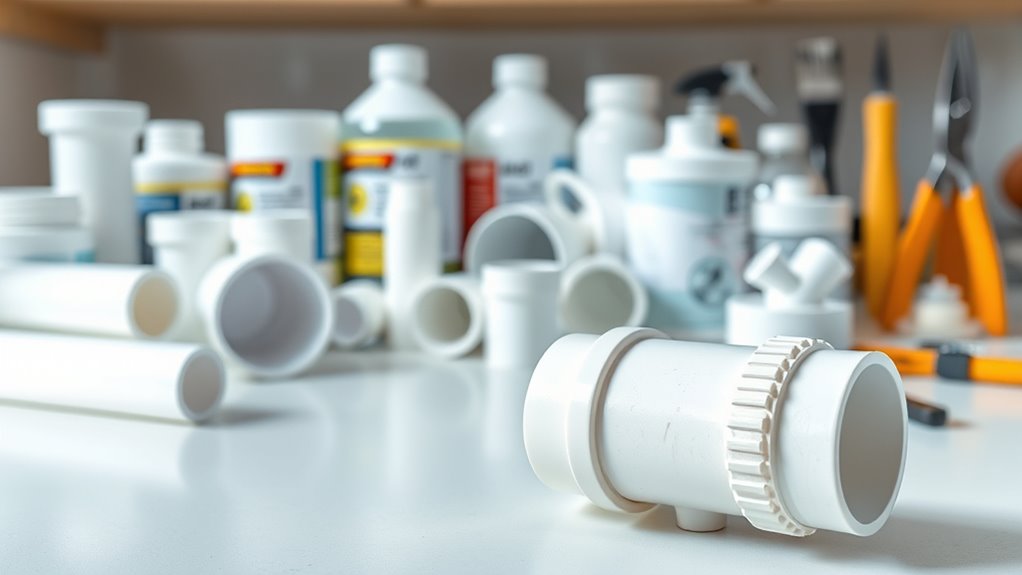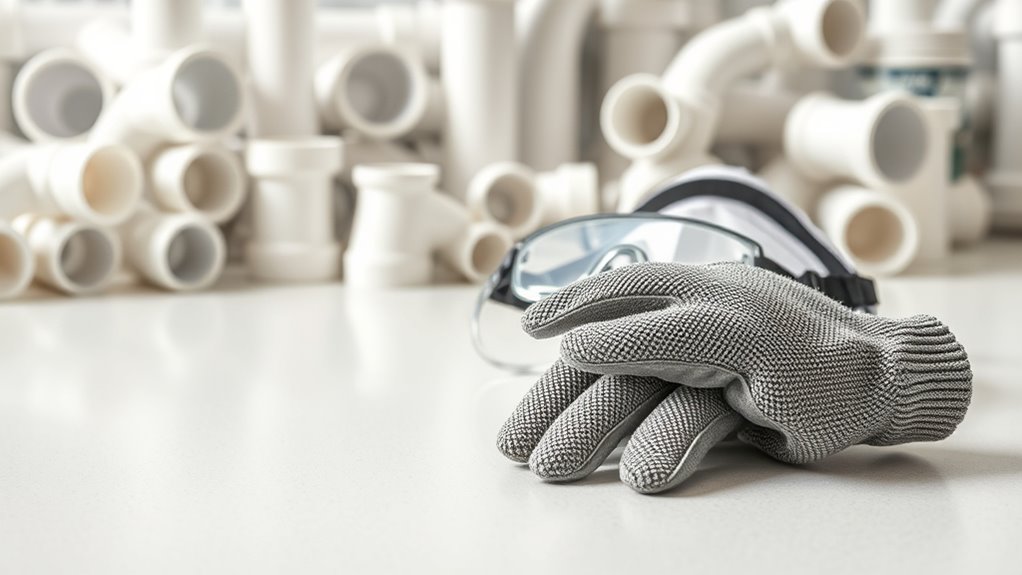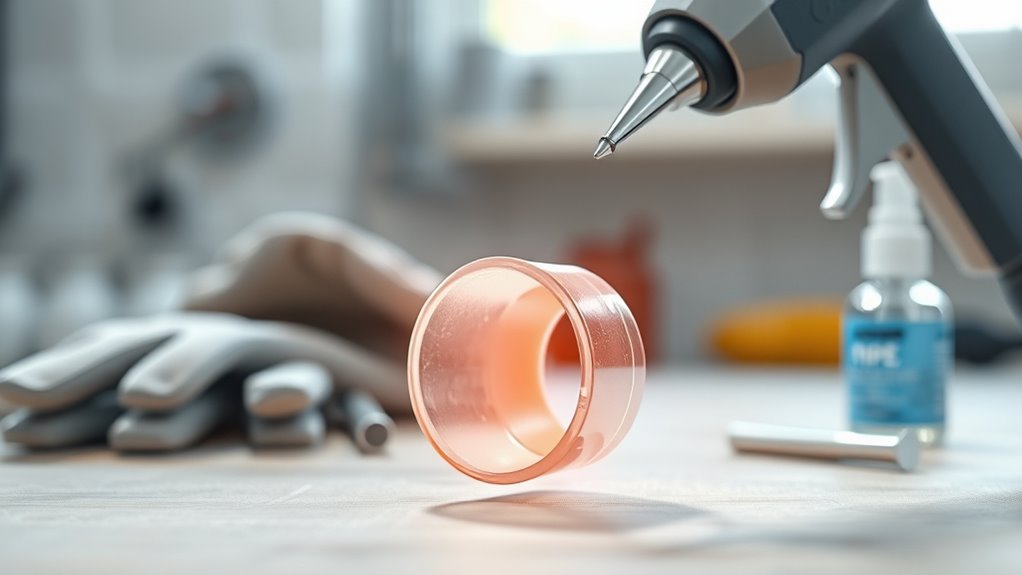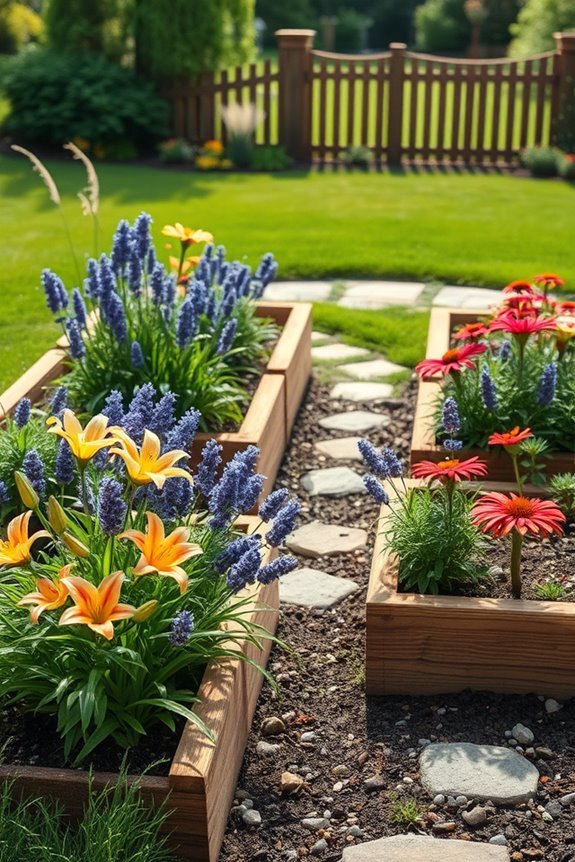How to Unglue PVC Pipe Safely Without Damaging Fittings
To unglue PVC pipe safely without damaging fittings, follow these steps:
- Assess the Situation: Identify the type of adhesive used and examine the condition of the pipe.
- Protect Yourself: Wear safety goggles and gloves to ensure your safety during the process.
- Apply Heat: Use a heat gun on a low setting to gently warm the adhesive around the joint, ensuring even heat distribution to soften the glue.
- Use a Solvent: Carefully apply a compatible solvent around the joint if necessary, but do so sparingly to avoid damage.
- Separate the Pipes: Once the adhesive is softened, carefully twist and pull the pipes apart.
- Inspect for Damage: After separation, check both the pipe and fittings for any signs of damage.
By following these methods, you can effectively unglue PVC pipes while preserving the integrity of the fittings.
Understanding PVC Pipe Adhesive

PVC pipe adhesive, or PVC cement, is essential for ensuring leak-proof connections in PVC piping systems.
This adhesive creates a robust bond between pipes and fittings, capable of handling high pressure. It works by softening the PVC material, allowing the surfaces to fuse together as it cures, resulting in a strong joint.
Available in various formulations for different applications, such as standard and schedule 40 pipes, proper usage is key.
Apply the adhesive evenly and allow sufficient curing time before applying any stress to the joint.
Understanding these properties and application techniques is crucial for anyone working with PVC systems to ensure their reliability and longevity.
Assessing the Situation Before Ungluing
Before ungluing PVC pipe, it’s essential to evaluate the situation carefully.
First, identify the type of adhesive used, as different adhesives require specific methods for removal.
Next, inspect the condition of the pipe and fittings to ensure they are not damaged, which could complicate the process.
This thorough assessment will help prevent damage and make the ungluing process safer and more efficient.
Identify Glue Type
Identifying the type of adhesive used on your PVC pipe is crucial for a safe and effective ungluing process. Different adhesives have unique properties that influence how you can remove them. Here’s a quick guide to help you determine the right approach for ungluing:
| Glue Type | Characteristics |
|---|---|
| PVC Cement | Fast-drying with a strong bond |
| PVC Primer + Cement | Requires a primer for effective bonding |
| CPVC Cement | Designed specifically for CPVC pipes |
| Specialty Adhesives | May need specific solvents for removal |
Knowing the glue type allows you to select the appropriate solvents or techniques to unglue without damaging the fittings.
Inspect Pipe Condition
To successfully unglue a pipe, evaluating its condition is crucial. Here are the key factors to inspect:
- Cracks or Fractures: Check for visible damage that could weaken the pipe.
- Discoloration: Look for unusual color changes, indicating potential chemical degradation.
- Surface Texture: Determine if the surface is smooth or rough, as this affects adhesion.
- Moisture Presence: Ensure the pipe is dry; excess moisture can complicate the ungluing process.
- Joint Stability: Verify that the joints are secure and not shifting, as this impacts ungluing effectiveness.
Conducting this thorough inspection is essential for a successful ungluing operation.
Evaluate Fitting Integrity
Evaluating the integrity of PVC pipe fittings is essential before attempting to unglue them.
Start by inspecting for cracks, chips, or any signs of wear that may compromise their strength during disassembly. Misalignment can also lead to complications and increase the risk of breakage.
A careful assessment of these factors will help you choose the right tools and methods for safe ungluing, ensuring a smoother and more efficient separation of the pipes.
Safety Precautions to Take

When working with PVC pipe and adhesives, taking safety precautions is crucial to avoid injury.
Always wear protective gear such as gloves and goggles, ensure the workspace is well-ventilated, and handle chemicals carefully.
These steps are vital for maintaining a safe environment during the ungluing process.
Wear Protective Gear
Before ungluing PVC pipe, ensure your safety by wearing the necessary protective gear. This is crucial for minimizing risks associated with the chemicals used during the process.
Here’s what you need:
- Safety goggles: To protect your eyes from splashes or debris.
- Nitrile gloves: To shield your hands from chemical exposure.
- Respirator mask: To avoid inhaling harmful fumes.
- Long-sleeved clothing: To protect your skin from adhesives.
- Knee pads: For comfort and protection while working on the ground.
Wearing this protective equipment creates a safer working environment and reduces the risk of injury.
Work in Ventilated Area
After putting on protective gear, it’s essential to choose a workspace that is well-ventilated for the ungluing process. A ventilated area reduces the risk of inhaling harmful fumes that may be released. Ensuring proper airflow allows dangerous vapors to dissipate quickly, enhancing safety.
Here are effective ventilation options to consider:
| Ventilation Options | Benefits |
|---|---|
| Open Windows | Increases fresh air flow |
| Exhaust Fans | Efficiently removes fumes |
| Outdoor Workspace | Provides natural ventilation |
| Air Purifiers | Reduces harmful particles |
Selecting a location with adequate ventilation not only improves safety but also creates a more comfortable working environment. Prioritizing proper ventilation is crucial for conducting the ungluing process safely and effectively.
Handle Chemicals Carefully
Handling chemicals safely is crucial during the ungluing process to prevent accidents and health risks. Follow these essential precautions when working with adhesives or solvents:
- Always wear personal protective equipment (PPE), including gloves and goggles.
- Read labels and safety data sheets (SDS) to understand hazards and first-aid measures.
- Store chemicals in a cool, dry place, away from sunlight and heat sources.
- Avoid mixing different chemicals unless specified, as reactions may produce harmful fumes.
- Dispose of waste materials according to local regulations to prevent environmental contamination.
Tools Required for the Process
To safely unglue PVC pipe, you’ll need a few essential tools:
- Heat Gun: This is crucial for applying controlled heat to soften the adhesive without damaging the pipe or fittings.
- Utility Knife: Use this to carefully cut away any excess adhesive surrounding the joint.
- Pliers or Channel Locks: These tools are necessary for gripping and manipulating the fittings during the ungluing process.
- Soft Cloth or Rag: This helps in cleaning the area and removing any debris.
- Safety Goggles and Gloves: Always wear these for protection against heat and chemicals.
Having these tools ready will streamline the process of ungluing PVC pipe safely and effectively.
Heating the Joint

To unglue a PVC pipe joint, applying heat is essential for softening the adhesive. Here’s how to do it safely and effectively:
- Use a Heat Gun: Set it to a low temperature to prevent damaging the pipe.
- Maintain Distance: Keep a safe distance from the joint to avoid burns or melting.
- Rotate the Joint: Periodically rotate to ensure even heat distribution.
- Watch for Distortion: Monitor the plastic for any signs of melting or warping.
- Cool Before Separation: Allow the joint to cool slightly before attempting to pull the pipes apart.
This method makes disassembly easier while protecting the fittings.
Using a Saw to Cut the Pipe
When cutting PVC pipe, choosing the right saw is crucial for a clean cut.
Ensure accurate measurement of the pipe length for proper fitting after cutting.
Familiarize yourself with different cutting techniques, as they can significantly impact the quality of the cut.
This knowledge will help you achieve the best results for your project.
Choosing the Right Saw
Choosing the right saw for cutting PVC pipe is essential for achieving clean and precise cuts. Here’s a quick guide to help you select the best tool based on your project needs:
- Hand Saw: Best for small projects where control is essential, but it requires more manual effort.
- PVC Pipe Cutter: Specifically designed for PVC, it delivers clean, straight cuts with ease.
- Miter Saw: Excellent for making angled cuts quickly and accurately, ideal for larger jobs.
- Reciprocating Saw: Versatile and suitable for rough cuts across various materials, including PVC.
- Band Saw: Perfect for continuous cuts and handling larger quantities of pipe efficiently.
Selecting the appropriate saw not only boosts cutting efficiency but also protects the integrity of the pipe and fittings.
Measuring Pipe Length
Measuring pipe length accurately is crucial for any project, as even minor errors can result in wasted materials and time.
To ensure precise measurements, use a reliable tool like a tape measure or yardstick. Always double-check your measurements against the project specifications. Remember to consider any fittings that may require additional length.
Clearly mark the cutting point on the pipe with a pencil or marker. By following these steps, you will streamline the cutting process and enhance the efficiency of your installation.
Cutting Techniques Explained
Cutting PVC pipes effectively ensures clean edges for proper fitting and sealing. Follow these essential techniques for optimal results:
- Select the Right Tool: Choose a fine-toothed saw or a PVC pipe cutter for smooth cuts.
- Stabilize the Pipe: Secure the pipe with a clamp to prevent movement during cutting.
- Mark Your Line: Use a marker to clearly indicate where to cut for precision.
- Cut with Care: Apply steady pressure while cutting to avoid damaging the pipe.
- Smooth the Edges: Use a deburring tool to eliminate rough edges, ensuring a tight seal.
These steps will help you achieve snug, leak-free connections with your PVC pipes.
Applying Solvents Carefully
To apply solvents effectively while minimizing risks, follow these steps:
1. Choose the Right Solvent: Select a solvent specifically formulated for PVC to ensure compatibility with the adhesive.
2. Ventilation: Work in a well-ventilated area to prevent inhalation of fumes.
3. Application Technique: Use a small brush or dropper to apply the solvent precisely around the joint.
Avoid applying excess solvent to prevent it from running into unwanted areas.
4. Allow Penetration Time: Let the solvent sit for several minutes to soften the adhesive bond.
Patience is key to preventing damage.
5. Protect Your Skin: Wear gloves to avoid skin irritation from the solvent.
Leveraging Mechanical Force
To effectively unglue PVC pipes, leveraging mechanical force can be highly beneficial.
By applying leverage, you can generate enough torque to break the bond between the pipe and the fitting.
Additionally, using heat can soften the adhesive, making it easier to separate the two components.
These methods can save you time and effort when tackling stubborn PVC connections.
Applying Leverage Effectively
To effectively unglue PVC pipe and separate stubborn joints, leveraging mechanical force is essential. Here are some practical methods to help you do this without damaging the fittings:
- Pipe Wrench: Use a pipe wrench for a secure grip on the joint, allowing you to apply torque effectively.
- Wooden Block: Insert a wooden block between the pipe and a sturdy surface to create leverage and distance, making it easier to pull apart.
- Crowbar: A crowbar can help you apply force at the joint while protecting the surrounding area from damage.
- Strap Wrench: For a gentler grip, a strap wrench can effectively hold the pipe while you twist it loose.
- Long Handled Tool: Consider a long-handled tool to enhance torque and reduce physical strain while working on the joint.
Using Heat Technique
Applying heat to PVC joints is an effective method for softening adhesive, making it easier to separate pipes. To use this technique, follow these steps:
- Select a Heat Source: Choose a heat gun or hairdryer. Ensure it has adjustable settings to control the temperature.
- Apply Heat Carefully: Direct the heat towards the joint area while moving the source in a circular motion. This helps distribute warmth evenly without damaging the fittings.
- Monitor the Temperature: Keep the heat at a moderate level to avoid warping or melting the PVC.
- Separate the Pipes: Once the adhesive softens, gently twist or pull the pipes apart.
Tapping the Joint Gently
Gently tapping a joint can effectively break the seal between glued PVC pipes without causing damage. To maximize success, consider these key tips:
- Use a rubber mallet to avoid cracking the pipe.
- Tap around the joint’s circumference to distribute pressure evenly.
- Increase force gradually, applying more only as needed.
- Keep a steady hand to avoid erratic movements that could damage the pipes.
- Support the pipes during the tapping process to prevent undue stress.
Following these guidelines can help you safely and effectively separate glued PVC pipes.
Inspecting the Fittings Post-Ungluing
Inspecting fittings after ungluing is crucial for ensuring they are safe and ready for reuse.
After separation, carefully check for any damage such as cracks, chips, or warping that could lead to leaks upon reassembly.
It’s also vital to inspect both the interior and exterior surfaces for any adhesive residue, which can hinder proper fitting with new pipes.
Ensure that fittings are clear of obstructions and assess their overall shape and alignment to confirm they are suitable for future projects.
This thorough inspection helps maintain a reliable plumbing system.
Cleaning the Fittings
Cleaning plumbing fittings is crucial for ensuring a secure seal and preventing leaks during reuse. Follow these essential steps for effective cleaning:
- Gently brush the fittings with a soft brush to remove debris and residue.
- Soak the fittings in warm, soapy water to loosen any stubborn dirt.
- Rinse thoroughly with clean water to remove soap and contaminants.
- Inspect the fittings for scratches or damage that could impact performance.
- Dry the fittings completely to avoid moisture affecting future adhesive applications.
Preparing for Reassembly
Before reassembling PVC fittings, ensure all components are ready for a secure fit. Check each fitting for damage or wear to avoid leaks.
Clean the surfaces of the pipe and fittings to remove debris, moisture, and old adhesive. Confirm proper alignment of the pipes and fittings for a successful connection.
Lightly sand the fitting edges if needed to improve adhesion. Lastly, gather all necessary tools and materials to ensure a smooth reassembly process.
Proper preparation is essential for a long-lasting installation.
Choosing the Right Replacement Parts
When choosing replacement parts for PVC pipe, ensuring compatibility with your existing system is crucial to avoid leaks and maintain integrity.
Here are key factors to consider:
- Pipe Diameter: Ensure the replacement pipe matches the size of your existing pipes for a proper fit.
- Material Type: Select PVC that meets the same ASTM standards as your original pipes.
- Fitting Type: Use the correct fittings (elbows, tees, etc.) that match your current configuration.
- Pressure Rating: Verify that the replacement parts can withstand your system’s pressure requirements.
- Sealants and Adhesives: Opt for compatible sealants to ensure a secure bond and prevent future problems.
Tips for Future PVC Pipe Installations
For successful PVC pipe installations, follow these essential tips:
- Choose the Right Size and Type: Ensure you select the appropriate diameter and type of PVC pipe and fittings based on your specific application.
- Clean and Prepare: Thoroughly clean both the pipe and fittings to ensure a strong bond with the adhesive.
- Use Primer: Always apply primer before the adhesive to enhance the durability of the connection.
- Curing Time: Allow the recommended curing time from the manufacturer before applying any pressure to the system.
- Cutting Techniques: Use a straight-cutting tool to avoid rough edges that could compromise seals.
- Consider Environmental Conditions: Be mindful of temperature and environmental factors during installation, as they can impact the bonding process and the overall performance of your plumbing system.
When to Call a Professional
Knowing when to call a professional for PVC pipe issues is crucial for successful plumbing projects. Here are key situations where expert assistance is advisable:
- Visible Damage: If there’s noticeable damage to pipes or fittings, it’s best to consult a professional to prevent further complications.
- Complex Configurations: For projects involving intricate plumbing layouts, an expert can ensure proper installation and avoid costly mistakes.
- High-Pressure Systems: Attempting to unglue pipes in high-pressure environments can be risky; professionals have the tools and experience to handle these safely.
- Unsuccessful Previous Attempts: If past efforts to unglue pipes have failed, an expert can provide effective solutions without causing additional damage.
- Thorough Inspections: When a detailed assessment of your plumbing system is required, professionals can identify issues that may not be visible to the untrained eye.
Engaging a professional in these scenarios can save time, money, and prevent further damage.
Conclusion
To safely unglue PVC pipes without damaging fittings, follow these key steps:
- Assess the Joint: Identify the type of adhesive used. If it’s PVC cement, you’ll need to apply heat carefully.
- Apply Heat: Use a heat gun or hair dryer on a low setting to gently warm the joint. Keep the heat moving to avoid damaging the pipe or fitting.
- Use a Wrench: As the joint softens, use a wrench to carefully twist and separate the pipes. Avoid excessive force to prevent breakage.
- Clean the Fittings: Once separated, clean any leftover adhesive from the fittings to ensure a smooth reassembly.
- Choose Quality Replacement Parts: If you need to replace any components, opt for high-quality parts to enhance durability in future installations.
- Know When to Seek Help: If the joint remains stubborn or if you’re unsure, it’s best to consult a professional plumber to avoid damaging your plumbing system.
By following these steps, you can effectively unglue PVC pipes while preserving your fittings.



